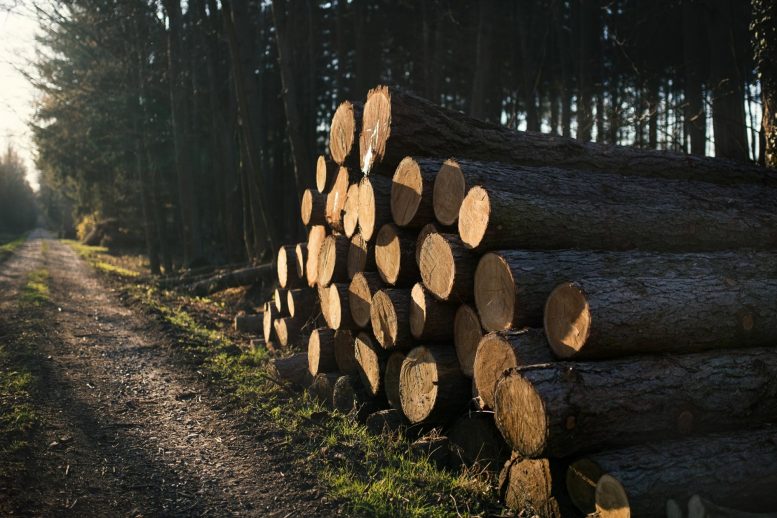
A recent study demonstrates the significant role that planting new commercial forests could play in combating climate change.
Future Wood Use Assures Long-Term Climate Benefit From Commercial Forests
A new study published in Nature Communications demonstrates the important role that planting new commercial forests could play in the fight against climate change by including new accounting of greenhouse gas (GHG) mitigation achieved from future use of harvested wood.
The study applied a novel, time-dependent assessment to capture the complex dynamics of carbon uptake, storage, and partial eventual release back to the atmosphere, alongside product and energy substitution by wood products, over a 100-year timeframe.
Uniquely, the study considered multiple wood uses along multi-decadal cascading value chains (e.g. construction timber to paper to bioenergy), and future projections on wider decarbonization of substituted products and energy (to avoid overestimating future substitution “credits” derived from use of wood).
“Our goal was to undertake a really comprehensive life cycle assessment that considers the whole life cycle of carbon taken up by trees in new commercial forests,” says Eilidh Forster, a PhD student in Bangor University and lead author of the study.
“Because new forests won’t be harvested for another 50 years, the standard assessment approach of applying current technology emission factors to wood value chains is inaccurate. Therefore, we decided to apply projections of future technology deployment to better represent the likely long-term climate change mitigation achieved by harvested wood.”
A major finding of the study is that future deployment of carbon capture & storage (CCS) technology — that extracts CO2 from exhaust gases during energy generation and locks it away in old oil and gas wells — transforms wood bioenergy into a “negative emission technology” capable of removing CO2 from the atmosphere long-term.
Assuming widespread use of CCS after 2070 means that new commercial forestry can be a long-term sink of CO2 from the atmosphere, even if a large share of wood is ultimately burned for bioenergy generation. However, the study also showed that a large share of carbon removed from forests during harvesting is locked up for many decades in wood products, such as sawn-wood and panel boards used for construction. Not only does this delay the release of carbon back to the atmosphere, but it “buys time” for successful commercial deployment of CCS technology in the future. For example, a significant share of wood produced in a forest planted today may not be combusted for another 100 years or more if it is used in a hierarchical value chain that prioritizes higher-value use in construction or advanced bio-based materials.
“In essence, afforestation is one of the few options available to offset current GHG emissions, but at the same time can provide a crucial feedstock for the circular bioeconomy that we expect to be expanding rapidly for decades into the future,” adds co-author Caren Dymond, Senior Research Scientist in natural resources with the Government of British Columbia.
The results of this study counter recent studies that suggest commercial forests act only as a short-term sink of CO2. In fact, these new results indicate that, where forest growth rates are high (e.g. temperate wet climates), new commercial conifer forests could deliver up to 269% more climate mitigation than semi-natural broadleaf forests by 2120. However, the authors stress that whilst this evidence supports the planting of new commercial forests in temperate regions as an effective climate mitigation strategy, a range of other considerations need to be taken into account for sustainable land use planning. Consideration of wider ecosystem services and biodiversity may favor a mix of forest types, including slower-growing and non-harvested broadleaf forests, and/or stands of mixed conifer and broadleaf species.
John Healey, study co-author and Professor of Forest Sciences in Bangor University, concludes:
“New commercial forestry doesn’t necessary have to be harvested in the future, depending on the future comparative value of keeping carbon “in the ground” versus storing it in various wood products and finally using it for bioenergy — preferably with CCS to keep it out of the atmosphere. Therefore, planting new commercial forests is a flexible way to contribute to long-term climate stabilization goals, and is remarkably robust to future assumptions about technological progress and wider decarbonization in the economy.”
Reference: “Commercial afforestation can deliver effective climate change mitigation under multiple decarbonisation pathways” by Eilidh J. Forster, John R. Healey, Caren Dymond & David Styles, 22 June 2021, Nature Communications.
DOI: 10.1038/s41467-021-24084-x









Pine trees are cut in 20 years, not 50, unless someone is doing serious thinning for larger diameter trunks.